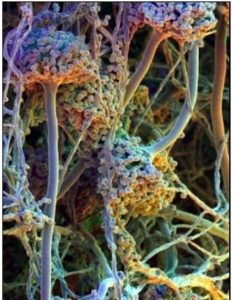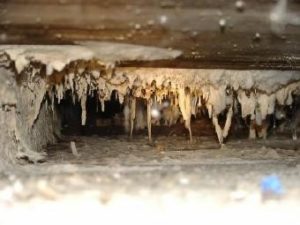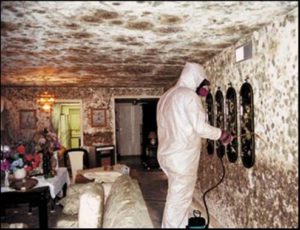Mold Inspections, Sampling and Abatement Services
 Molds are ubiquitous in nature, and are a common component of household and workplace dust. When molds reproduce they make spores. The spores are carried by air currents and when they land on a moist surface that is suitable for life, they begin to grow.
Molds are ubiquitous in nature, and are a common component of household and workplace dust. When molds reproduce they make spores. The spores are carried by air currents and when they land on a moist surface that is suitable for life, they begin to grow.
Mold is normally found indoors at levels that do not affect most healthy individuals. However, when spores are present in large quantities, they can be a health hazard, potentially causing allergic reactions and respiratory problems. Some molds also produce mycotoxins that can pose serious health risks. The term “toxic mold” refers to molds that produce mycotoxins, such as Stachybotrys Chartarum. Exposure to high levels of mycotoxins can lead to neurological problems and in some cases death. Prolonged exposure, such as in the residence or daily workplace exposure, can be particularly harmful.
 A mold inspection is performed to determine if mold is present and identify the environment that is allowing the mold to grow. This is done by visually examining the building. If mold is visible, an intrusive investigation is not usually necessary. However, sometimes more intrusive methods are needed to assess the situation, including moving furniture and equipment, lifting and removing carpets, checking above ceilings and behind walls, and checking in ventilation systems.
A mold inspection is performed to determine if mold is present and identify the environment that is allowing the mold to grow. This is done by visually examining the building. If mold is visible, an intrusive investigation is not usually necessary. However, sometimes more intrusive methods are needed to assess the situation, including moving furniture and equipment, lifting and removing carpets, checking above ceilings and behind walls, and checking in ventilation systems.
To further evaluate and delineate the mold growth, sampling may be necessary. When sampling is necessary it should be performed by a trained professional who has specific experience in designing mold sampling protocols, sampling methods, and the interpretation of findings. Sampling can include the collection and analysis of bulk, wipe and air samples.
 In most cases, if mold is found it will need to be abated. Common abatement methods for small occurrences of mold include drying the affected area, ventilating, disinfecting, and use of mold inhibitors. Significant mold growth may require the removal of affected building materials. A conservative strategy is to discard all building materials that are wet or have visible mold growth. In extreme cases of mold growth, it may be easier and more cost effective to condemn the building rather than clean the mold to safe levels.
In most cases, if mold is found it will need to be abated. Common abatement methods for small occurrences of mold include drying the affected area, ventilating, disinfecting, and use of mold inhibitors. Significant mold growth may require the removal of affected building materials. A conservative strategy is to discard all building materials that are wet or have visible mold growth. In extreme cases of mold growth, it may be easier and more cost effective to condemn the building rather than clean the mold to safe levels.
Total Environmental & Safety, LLC’s (Total) associates include Certified Mold Assessors, Certified Industrial Hygienists (CIH), mold abatement specialists, and other certified safety professionals trained and experienced in identifying, evaluating and abating mold.


